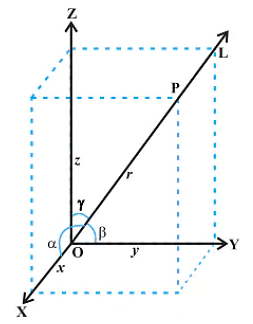If a straight line makes angles $\alpha , \beta , \gamma $ with the coordinate axes, then $\frac{1-\tan^{2} \alpha }{1+tan^{2} \alpha} +\frac{1}{sec 2 \beta} -2\sin^{2} \gamma =$
- -1
- 1
- -2
- 2
The Correct Option is C
Solution and Explanation
Then, $\cos ^{2} \alpha+\cos ^{2} \beta+\cos ^{2} \gamma=1$
$\Rightarrow \frac{1+\cos 2 \alpha}{2}+\frac{1+\cos 2 \beta}{2}+1-\sin ^{2} \gamma=1$
$\Rightarrow 1+\cos 2 \alpha+1+\cos 2 \beta+2-2 \sin ^{2} \gamma=2$
$\Rightarrow \cos 2 \alpha+\cos 2 \beta-2 \sin ^{2} \gamma=-2$
$\Rightarrow \frac{1-\tan ^{2} \alpha}{1+\tan ^{2} \alpha}+\frac{1}{ sec\, 2 \beta}-2 \sin ^{2} \gamma=-2$
Top Questions on Three Dimensional Geometry
- If m:n is the ratio in which the point $\left(\frac{8}{5}, \frac{1}{5}, \frac{8}{5}\right)$ divides the line segment joining the points (2,p,2) and (p,-2,p) where p is an integer then $\frac{3m+n}{3n}=$
- TS EAMCET - 2025
- Mathematics
- Three Dimensional Geometry
- If A(2,1,-1), B(6,-3,2), C(-3,12,4) are the vertices of a triangle ABC and the equation of the plane containing the triangle ABC is $53x+by+cz+d=0$, then $\frac{d}{b+c}=$
- TS EAMCET - 2025
- Mathematics
- Three Dimensional Geometry
- If $(\alpha, \beta, \gamma)$ is the foot of the perpendicular drawn from a point $(-1,2,-1)$ to the line joining the points $(2,-1,1)$ and $(1,1,-2)$, then $\alpha+\beta+\gamma=$
- TS EAMCET - 2025
- Mathematics
- Three Dimensional Geometry
- Let $\pi_1$ be the plane determined by the vectors $\hat{i}+\hat{j}, \hat{i}+\hat{k}$ and $\pi_2$ be the plane determined by the vectors $\hat{j}-\hat{k}, \hat{k}-\hat{i}$. Let $\vec{a}$ be a non-zero vector parallel to the line of intersection of the planes $\pi_1$ and $\pi_2$. If $\vec{b} = \hat{i}+\hat{j}-\hat{k}$ then the angle between the vectors $\vec{a}$ and $\vec{b}$ is
- TS EAMCET - 2025
- Mathematics
- Three Dimensional Geometry
Show that the following lines intersect. Also, find their point of intersection:
Line 1: \[ \frac{x - 1}{2} = \frac{y - 2}{3} = \frac{z - 3}{4} \]
Line 2: \[ \frac{x - 4}{5} = \frac{y - 1}{2} = z \]
- CBSE CLASS XII - 2025
- CBSE Compartment XII - 2025
- Mathematics
- Three Dimensional Geometry
Questions Asked in KEAM exam
- A lift having mass 1000kg moves upward against a frictional force of 2000N. Power given by motor is 36000W. What is the velocity of the lift?
- KEAM - 2025
- Speed, Time and Distance
- Solve for \( a \) and \( b \) given the equations: \[ \sin x + \sin y = a, \quad \cos x + \cos y = b, \quad x + y = \frac{2\pi}{3} \]
- KEAM - 2025
- Trigonometry
- If \( A \) is a \( 3 \times 3 \) matrix and \( |B| = 3|A| \) and \( |A| = 5 \), then find \( \left| \frac{\text{adj} B}{|A|} \right| \).
- KEAM - 2025
- Matrix Operations
- An unbiased die is tossed until a sum \( S \) is obtained. If \( X \) denotes the number of times tossed, find the ratio \( \frac{P(X = 2)}{P(X = 5)} \).
- KEAM - 2025
- Probability
- If $ f(x) = \log 3 - \sin x $, $ y = f(f(x)) $, find $ y(0) $.
- KEAM - 2025
- Functions
Concepts Used:
Three Dimensional Geometry
Mathematically, Geometry is one of the most important topics. The concepts of Geometry are derived w.r.t. the planes. So, Geometry is divided into three major categories based on its dimensions which are one-dimensional geometry, two-dimensional geometry, and three-dimensional geometry.
Direction Cosines and Direction Ratios of Line:
Consider a line L that is passing through the three-dimensional plane. Now, x,y and z are the axes of the plane and α,β, and γ are the three angles the line makes with these axes. These are commonly known as the direction angles of the plane. So, appropriately, we can say that cosα, cosβ, and cosγ are the direction cosines of the given line L.
